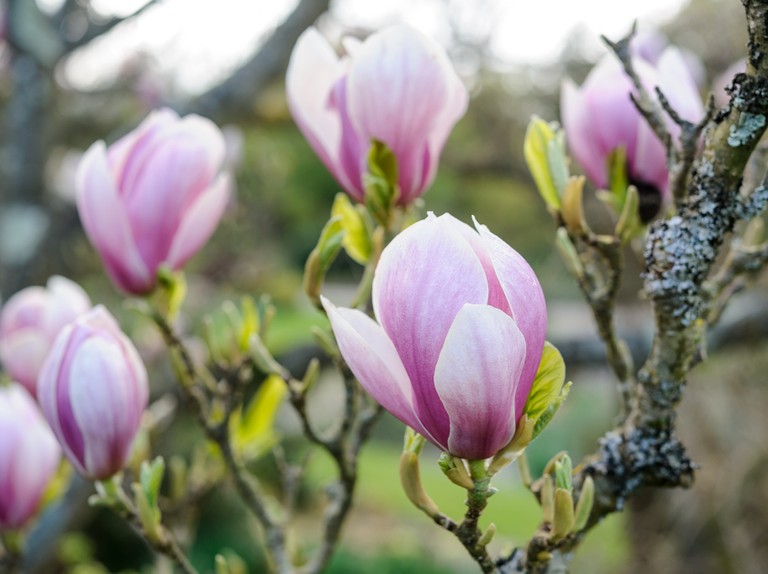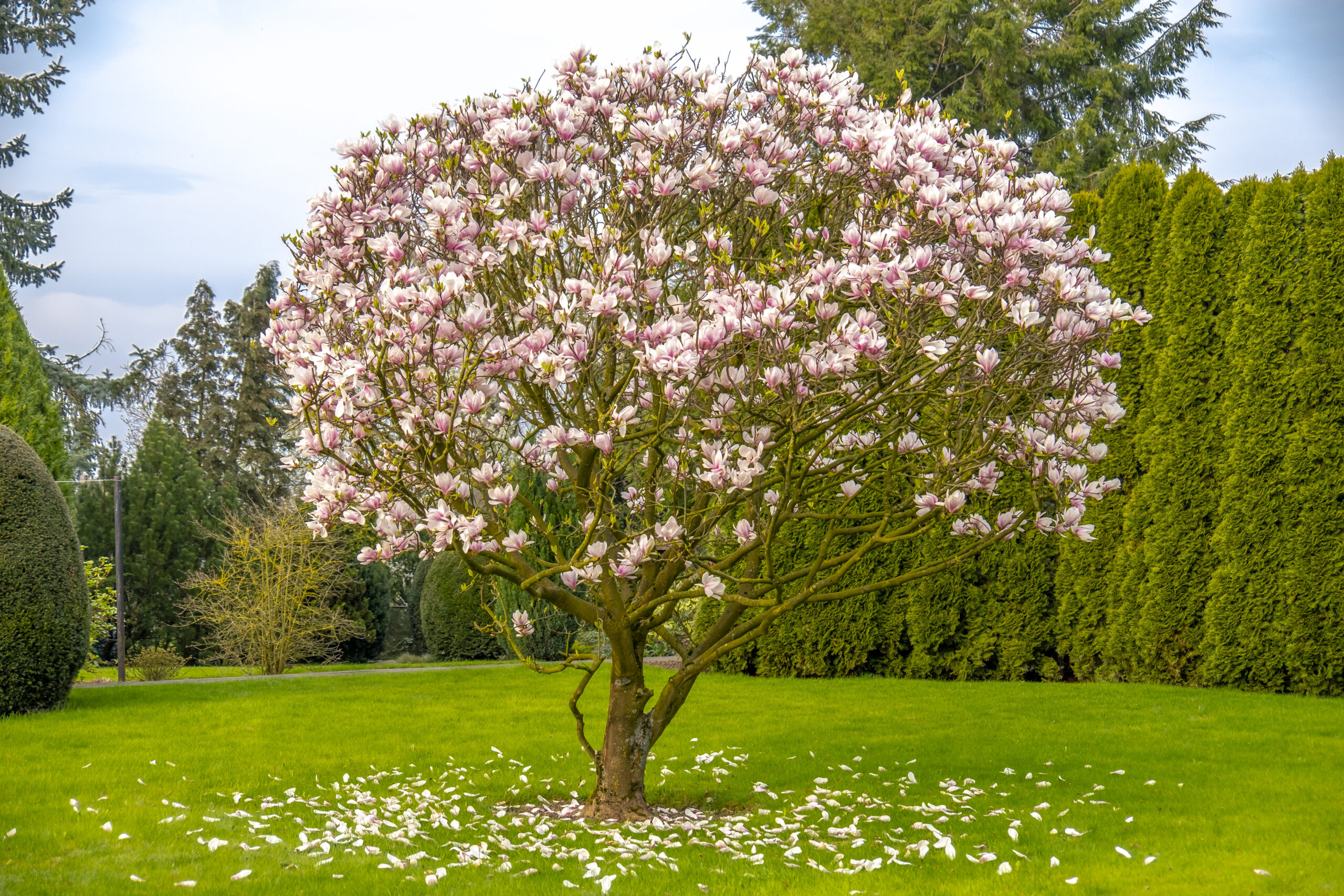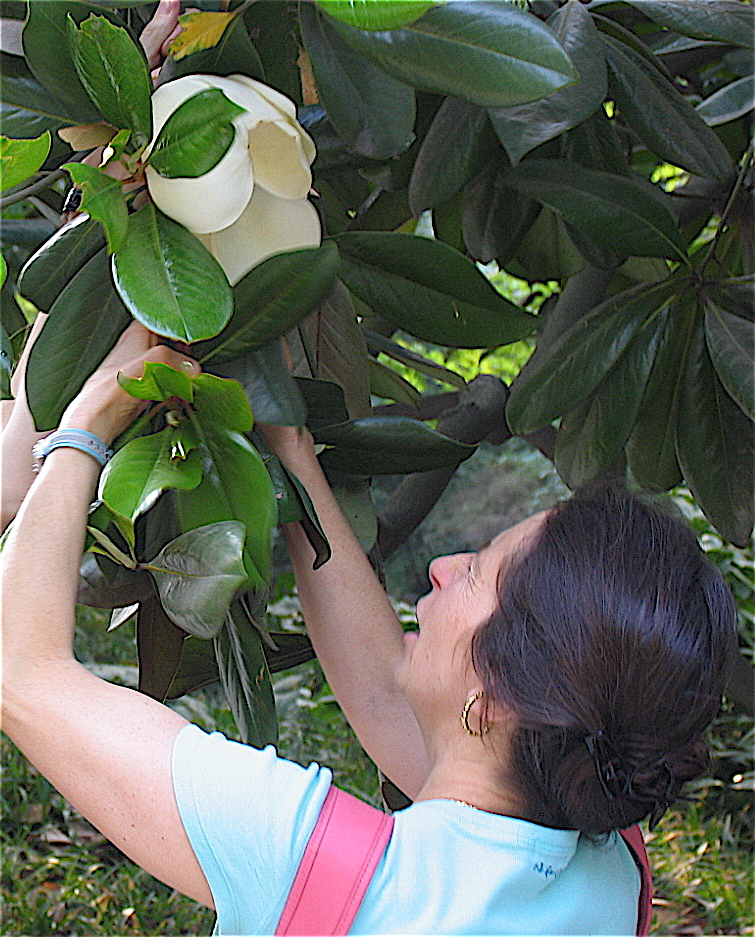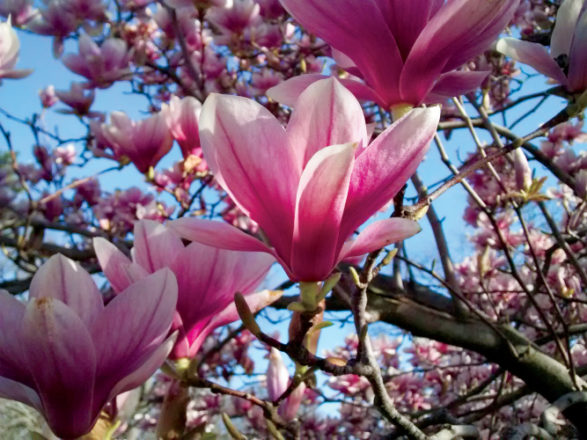Magnolia (Magnolia grandiflora) is a member of the Magnoliaceae plant family. There are more than 240 different species, many of them deciduous as well as evergreen ones among them. The tree is native to south and south-east Asia, especially India. The name Magnolia was given in honor of Pierre Magnol (1638-1715), a French professor of botany and director of the Botanical Garden in Montpellier. He was one of the first scientists to establish the current scheme of botanic descriptions and classifications of plants. There is scientific evidence that Magnolia is an ancient genus. Fossilized Magnolia flowers together with the bugs being its foremost pollinators have been found in rocks reaching back about 100 million of years.

The Magnolia tree is very tall and grows up to about 30 m. It loves full sun and produces abundant foliage with quite large, oval leaves arranged alternately. The flowers are large, sometimes huge, and very charming in their shape and colour. Since evolution apparently brought them out before bees appeared they must have attracted beetles for pollination. Champaca, the famous Michelia champaca, is from the same family, also known as ‘Joy Perfume Tree’. It is famous for its sweet, floral, exotic fragrance and contained in the most expensive perfume aromas. The oil has also reputation as an aphrodisiac.
In the wild we find Magnolias growing in tropical and subtropical climates where they prefer evergreen forests with humid soils. Some of the species are quite adapted and grow wild in the Himalayas, Japan, China and North America. Magnolia trees have become much reduced in the wild due to exploitation for its fine timber being in high demand for constructions of buildings, also for furniture, toys and carvings.
Over time the beautiful Magnolia with its rich magnificent blossoms has conquered countries and continents all over the world. It is not only popular for its lovely blossoms and for affording shade, but also for its wonderful fragrance which enchants everybody during the blossoming time. It is often compared to the fragrance of the Lotus flower, another magnificent queen of the blossoms. Magnolias perfume can often be perceived hundreds of meters away; a single flower is enough to fill a car or a room with it aroma.
Magnolia in its cultural context
Originally, the use of odorous substances in some cultures was left to the sacred acts and rituals performed by priests or those possessing the political power. In an Indian encyclopaedia (Manasollasa) of the 12th century the plant is named as most significant component of royal massage oil. In Buddhist and Hindu temples and gardens Magnolia still today has great ritual significance. Women use to wear the blossoms as headdress at dancing ceremonies and weddings, where the buds open during dancing and start filling the room with their sense delighting fragrance. They also make garlands of the blossoming twigs or have the flowers at home in bowels of water to spread the fine, fruitful fragrance in their rooms. The aromatized water is then used for blessing rituals in the home and sprinkled during prayers. The Magnolia tree is regarded as personification of the Goddess Lakshmi who is believed to be the Deity of wealth, prosperity, fertility, wisdom, generosity and courage. Hindus dedicate the essential oil to Lakshmi’s consort Lord Vishnu, the sustainer. Certain rituals in Indian temples are connected with the Magnolia flower to mark transitions of life time like marriage, birth, death etc.
In the 7th century monks are said to have brought Magnolia to China where it soon became equally popular as Jasmine – and like Jasmine it finds application to flavour tea until today. In China pleasant smells like Champaca, another Magnoliacea, were believed to nourish the soul and open the door to Paradise. Traditional Chinese medicine speaks about Magnolia as bestower of Qi’, the inner vital energy in man which regulates everything between body, mind and spirit – very similar to Prana in Ayurvedic tradition. Chinese medicine believes that if Qi’ is blocked all kinds of health problems are the result.
Southeast Asian culture is imbibed with the use and symbolism of the Magnolia flower. It is often also associated with birth and regeneration. In Indonesia it is common that newly married women or brides decorate themselves with Magnolia blossoms to show that they are beginning a new cycle of their life.
Magnolia’s oils
One way to produce the essential oil of Magnolia is through standard distillation from the leaves. China is the largest producer of this oil. There is also an essential oil from the bark of the Magnolia tree. In China it is known that extracts or oils from the bark promote energy circulation. Magnolia leaf oil is colourless with a fresh-sweetish note reminding us of Petitgrain with a bit of Palmarosa. The only way to obtain an essential oil from the blossoms is first to use solvent extraction yielding a kind of greenish semi-solid “concrete”. This then can be distilled to obtain around 10 % of an essential oil. Like with many oils from blossoms Magnolia’s delicate flowers exhale most of their perfume during the night. So, their harvesting is done when it is dark or in the early morning when the aroma is at its peak. Extraction is best to follow as soon as possible. The oils from leaves of flowers are used in aromatherapy, cosmetic and perfume industry. They blend well with flower-, wood- and resinous oils.

Some main bio-chemical compounds found in Magnolia oils are:
2-Phenylethanol (40% and 61%), (E,E)-farnesol (18%) and 2-phenylethanol (10%), germacrene D (17%) and ?-bisabolene (17%).
Some other studies on the oil from Magnolia grandiflora show the following compounds : cyclocolorenone (up to 39.6 %), bicyclogermacrene (1.2–25.2 %), germacrene D (2.3–23.8 %), isobornyl acetate (trace to 16.0 %), methyl myristate (up to 15.3 %), ?-pinene (3.3–14.6 %), ?-elemene (3.3–12.8 %), (2Z,6E)-farnesol (up to 15.0%), and (2E,6E)-farnesol (up to 12.5%).
In Ayurvedic medicine Magnolia is assigned to the Throat Chakra (Vishudda) and has proven purifying results on it. This Chakra is the seat of our voice which expresses our emotions, moods, beliefs, fears, goals, desires, communication skills and patterns. And not to forget: Our voice is connected to the lungs and to our breathing – and here the oil acts as a helpful remedy with its anti-inflammatory and expectorant properties in case of respiratory problems. Moreover it unfolds cooling effects to the body when reduction of temperature is required. Thus it is evident that Magnolia oil can be a good choice as a medicinal component in case of flu therapy. Furthermore, the essential oil is recommended to treat cellulite problems. It contains also Monoterpenols which are known as beneficial for skin care.
In Traditional Chinese Medicine (TCM) Magnolia flowers due to their warming quality have also to do with our “external organs” such as the ears, the nose, the throat or the skin. Magnolia flower oil is considered good for people who are invaded by the cold element (Yin) in their body. With warming elements (Yang) this can be counteracted. Harmony between Yin and Yang is a major concept in TCM. Since there is also a pungent taste in Magnolia flowers the oil will promote the circulation of Qi’ and body fluids. This is also a reason why people sweat and thereby liberate toxins form the body when they absorb or use spicy or warming ingredients. Magnolia also is connected to the stomach and the lungs and thereby co-responsible for our body fluids.
Furthermore, the flowers and oils of Magnolia are able to stimulate the production of neuro-transmitters like Serotonin, Encephalins and Endorphines.
- Serotonin has calming, soothing and relaxing effects. Lack of Serotonin may lead to nervousness, inner restlessness and also cause problems with the metabolic system.
- Encephalins are able to relieve pains, keep our mood in harmony and strengthen our self-confidence.
- Endorphines increase our zest for life, let us feel happy and enable our heart energies to shine through.
Easy to understand that these properties unfold balancing influences on the emotional side of our consciousness which is so much susceptible to stress factors and which needs constant attention to keep our psychology in harmony.

Good for the skin:
“Formulated from various compounds including beta-caryophyllene, Magnolia Oil possesses potent anti-inflammatory properties. When used on the skin, Magnolia Essential Oil helps to reduce redness, puffiness and leaves the appearance of skin more even and luminous… Magnolia Essential Oil is a nourishing tonic for the skin. As an excellent moisturizer, Magnolia Oil can help plump the appearance of skin and act as the ideal element to smooth the look of fine lines and wrinkles.”
https://www.decleor.co.uk/blogs/Magnolia.html
Scientific studies on Magnolia species
Magnolia against pathogenic foodborne bacteria
“The results of this study suggest that Magnolia liliflora Desr. mediated oil and extracts may act as an alternative to synthetic bactericides for using in the food industries, where bacterial pathogens cause severe destruction. The use of plant extracts and essential oils in consumer goods is expected to increase in the future due to the risk of “green consumerism,” which stimulates the use and development of products derived from plants (Tuley de Silva 1996), as both consumers and regulatory agencies are more comfortable with the use of natural anti-microbials. However, if plant oils and extracts are to be used for food preservation purposes, issues of safety and toxicity will always need to be addressed.”
In vitro Inhibition of Food Spoilage and Foodborne Pathogenic Bacteria by Essential Oil and Leaf Extracts of Magnolia liliflora Desr. V.K. BAJPAI, A. RAHMAN, N.T. DUNG, M.K. HUH, AND S.C. KANG
“A recent (2013) study by Chinese researchers exposed artificially stressed neurons to polyphenols from Magnolia bark, either from the species native to China, M. officinalis, or the species found in Japan, M. obovata. These poly-phenols suppressed both the oxidative and inflammatory response of the nerve cells. As the research team points out, their work follows on previous laboratory studies showing the antioxidant potential of Magnolia bark extract, such studies prompted by the traditional use of Magnolia in Chinese and Japanese medicine.”
https://www.sciencedirect.com/science/article/abs/pii/S0378874118341515
Summarizing the benefits
good for
- allergies, asthma, and respiratory infections.
- relief for allergenic reactions and congestion.
- topical application to reduce fevers
- rheumatism
- malaria
- regulating female hormones
- use as an emollient that nourishes the skin and balances oil secretions.
- calming the nerves while stimulating awareness, increasing overall confidence, and acting as an aphrodisiac.
- treatment of scars caused by acne and wounds.
- repair of damaged skin cells and pigmentation resulting from sun burn.
- joint pain caused by gout and rheumatism.
- use as an additive in gum and mints to treat bad breath.
cf also https://www.healthbenefitstimes.com/Magnolia-essential-oil/

A few thoughts on the principle of the blossom
Essential oils, according to Alchemy, are linked to the element of Sulfur, the warming, heating principle in Nature. In terms of Ayurveda we can say that they have a natural connection with the cosmic energy of “Agni”. The essential oils are considered as volatile Sulfur and –”it is precisely this Sulfur that gives every plant its special individuality. The Sulfur is always that which is truly individual, the soul, its essence. This is the reason why these oils are called essential oils.”
Manfred Junius, “Spagyrics: The Alchemical Preparation of Medicinal Essences, Tinctures, and Elixirs”
Coming to the blossom, botanically it is definitely the warmest organ in any plant. Root from the soil means “cold” – and Blossom from the Sun means “warm or hot”. In plants it is clearly the Sulfur processes which take place in the blossom, where the plant dissipates itself into scent, nectar, and abundant seed production—thus communicating with its environment. It is the level of the „formative principle“ (R. Steiner) – short-living, but very expressive in terms of shape and colours etc. Blossoming is the final evolutionary step of a plant before the fruit. It means – according to Anthroposophy – to come nearer to the realm of animals and human beings. And in the development of fruits and seeds certain substances are created that correspond to a higher degree of metabolism comparable to that of animal and man, for example hormone-like substances, alkaloids, etc.
This development from the leaves to the blossom to the fruits and seeds becomes possible due to an additional charge of cosmic fire. Rudolf Steiner explained that in the blossom the plant receives a maximum of structuring energy and intelligence through the “akashic” or cosmic influence of its corresponding Deva or vegetal Self. In the blossom it is as if the Devic energies rise to their maximum and the contact of the plant with the cosmic forces become highly intense.
We can truly say: In the blossom the plant creates and exposes maximum of its bio-chemical and energetic richness. And it opens itself up to its very special “plant identity”. Each blossom, much more than the level of the leaf, the stem or the root, is a very special expression of Nature’s quest for diversification – look at the hundreds of thousands of different blossoms in the Plant Kingdom! Means: quest for maximum expression of creativity, maximum individualization, including richness of shape, abundance of colour, infinity of bio-chemical compounds, exuberance of fragrance… And if a plant has also essential oils in the leaves, in the stem, the wood, the resin, the root… the SULFUR element has penetrated these areas and warmed them up, coloured them up, made them fragrant. We remember Rudolf Steiner saying: “In the Rosewood tree the wood starts to blossom”

To conclude:
Magnolia is a very special representative of the blossoming plants in Nature. It is rather psycho-spiritual than physical given its intense expression of the floral energy it contains. It is hard to find similar examples of this desire for creating such an overwhelming abundance in the realm of flowering bushes or trees.
Magnolia helps us in this to enjoy the intensity and sharpness of our senses thereby also inspiring and firing up our imagination. Therefore it is not surprising that the Magnolia fragrance supports the dream state to transmit its messages to the dreamer. It can help us to receive impulses to gently regain spiritual power by getting more detached from the burdens of stress and overworking – a factor where essential oils, especially from precious flowers like Magnolia, can open doors which may have been closed since long.
Magic blossom power to support us for letting our breath flow and our heart rejoice and for opening us up to spread the wings of our soul and touch the Divine spheres where our true being exists.